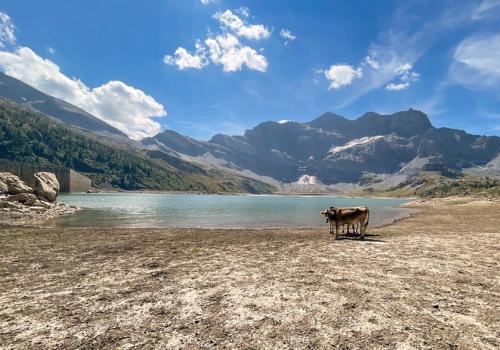At the Salanfe dam at the foot of the snowless Dents du Midi peaks in southern Switzerland, thirsty cows gulp down water from the slowly shrinking reservoir. This summer the mountain lake is about 15 metres lower than normal after losing 8 million cubic metres of water. “It’s an exceptional year,” says the waitress at the Auberge de Salanfe hostel overlooking the reservoir. “There is no more glacier, so the lake only gets melted snow.” While the levels of some Alpine dam reservoirs are much reduced this summer, others are surprisingly full – even overflowing – especially those below melting glaciers (click on video below). Surrounded by thick pine trees, the 122-metre Gebidem dam in canton Valais holds over 9.2 million cubic metres, or almost 4,000 Olympic swimming pools-worth, of icy-blue meltwater from Europe’s biggest glacier, the Aletsch. The summer heatwaves have caused the Aletsch to melt at a record rate. As a result, the Gebidem dam received so much meltwater that for several weeks in July and August the precious liquid went to waste. Every second 75,000 litres flowed over the dam into the void before it could pass through the turbines. Hydropower is a cornerstone of Switzerland’s energy policy. In 2021, the country generated 61.5% of its electricity from hydropower, 28.9% from nuclear energy, 1.9% from fossil fuels and 7.7% from other renewable sources. It typically produces more than enough power in the summer months. But it is forced to turn to imports from Europe to meet the gap when the cold sets in. That is not usually a problem, but this year power shortages are looming. The war in Ukraine, Russia’s cut-off of gas delivery to much of Europe and the shutdown of half of France’s nuclear power plants for maintenance and repairs are all contributing factors.
Europe’s hot, dry weather has also aggravated the energy crisis. Almost half of Europe is currently affected by extreme drought. Following a dry winter, Switzerland has recordedExternal link its second-hottest summer since measurements began in 1864 with three heatwaves. Lakes and rivers, especially in eastern, central and southern parts of the country, have dropped to record lows. ‘On track’ But whereas hydropower generation across Europe was reportedly down 20%External link for the first half of 2022 - Italy, Portugal and Spain were among the worst affected – Switzerland seems to be bucking the trend thanks to glacier meltwater. Swiss hydropower firms experienced a smaller 12% drop in production for the first five months of this year compared with 2021, according to Jürg Rauchenstein, a member of the Federal Electricity Commission (ElCom). Yet the severe lack of rain has raised fears about whether sufficient reservoir reserves can be built up to help secure the country’s electricity needs through the coming winter. The overall fill rate of Switzerland’s 200 biggest dams currently stands at 79% (as of August 29). Some observers, like Bettina Schaefli, a hydrology professor at the University of Bern, are optimistic about the situation. The fill-rate is below average, but reservoir-filling looks to be “on track”, she says. “Last winter we had very little snow so there was a lack of water from snowmelt. But the glaciers in dam catchment areas have provided a lot of water this summer,” says Schaefli, who is also president of the Swiss Hydrological Commission. “The dam reservoirs are actually too small to take all the water. At the moment there's more water coming than what we can actually store for the winter.”
Half of Switzerland’s hydropower comes from dams, the other half is generated by smaller structures along rivers, so-called run-of-river power plants, such as those on the Rhine. These had clearly been hit by the drought, said Schaefli, but she believes losses are being compensated by the large Alpine plants that are operating normally. Some Swiss hydropower operators and electricity companies even appear to be benefiting from current electricity shortages and high prices. “It’s a very good situation,” Daniel Fischlin, chief executive officer of the Oberhasli power plant in canton Bern, told Swiss public television, SRF. His firm’s turbines have been running at full speed in recent weeks. “Demand for electricity is great… a certain reserve has already been created.”
